
From September 21, 2020, "Special Exhibition Craft 2020-The Shape of Nature and Beauty-" is being held at the Tokyo National Museum Hyokeikan in Ueno, Tokyo. (Until November 15th)
A preview for the media was held on the 20th, and the Kokosil editorial department also visited us! In this article, we will report on the situation of the venue and the impressions of actually seeing the exhibited works from a beginner's perspective.
I will write it first, but even the author, who is not very familiar with crafts, enjoyed it enough, so even if you are worried that "I'm a little worried, but it wouldn't be interesting without knowledge …?" Please come and visit us!
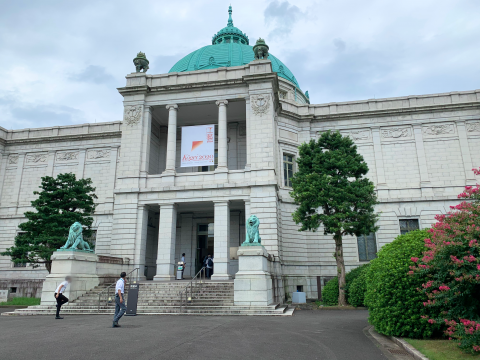
Tokyo National Museum Hyokeikan
What is "Special Exhibition Craft 2020-The Shape of Nature and Beauty-"?
This exhibition was planned as part of the "Japan Expo" promoted by the government and the "Spinning Project" that protects and conveys the beauty of Japan undertaken by the Agency for Cultural Affairs, the Imperial Household Agency, and the Yomiuri Shimbun.
From young people who will lead the next generation to living national treasures, the excellent works of 82 contemporary craft artists are gathered together. This is a special exhibition that highlights "Japanese people and nature," which is the general theme of "Japan Expo," through crafts.
The collected crafts are characterized by a wide variety of genres, such as " porcelain," "dyeing and weaving," "lacquer work," "metalwork," "wood and bamboo work," "dolls," and "cloisonne, glass, and kirikane ."
You can feel the Japanese view of nature, which has regarded nature as beauty and harmony, from a variety of works that combine traditional and contemporary sensibilities.
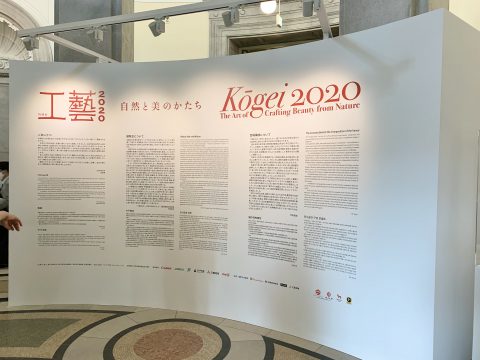
entrance
The keyword of the exhibition is "color"
What kind of exhibition structure do you think of when you think of an exhibition of works of art?
It's popular to introduce each genre by era, but this exhibition is a little interesting.
It is roughly divided into four areas, and the standard for the distribution is the color of the craft work .
■ ■ Chapter 1 gold shines forever, silver shines in the nobility
■ □ Chapter 2 Black absorbs all colors inside, and white repels all light.
■ ■ red of Chapter 3, life, nature of the gas
■ ■ Chapter 4 water blue is beyond time and space, green trees and mountains Ibuku life
Gold and silver, black and white, red and ki (yellow), blue and green. The power of life in crafts and nature, symbolized by each color.
By appreciating each color together, you may be able to become more aware of the view of nature that the Japanese have nurtured.
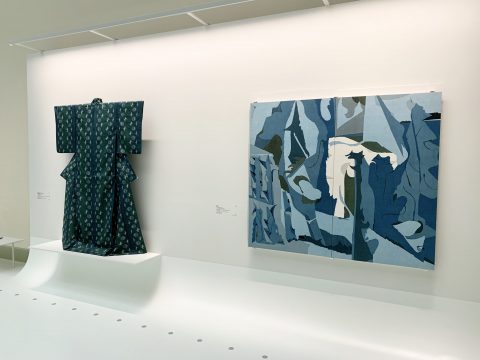
(Photo right) Teiji Nakai "Mori Tadashi" 2012 / Dyeing / Dyeing / Seiryukanzo (Photo left) Sasaki Enoko "Tsumugi Kasuri Kimono" Hana Tentsukichi "" 2005 / Dyeing / Private collection
What is interesting is that the impression of color at first glance does not always match the division that is actually exhibited.
For example, Teiji Nakai's "Masaaki Mori " is a work that makes you feel the movement and vitality of all things in the forest, and most of it is composed of indigo and green. However, this work is exhibited in Chapter 2 (black and white) instead of Chapter 4 (blue and green).
"Why is this work classified in Chapter 2?"
"What role does the color white or black in this work really play?"
It may be fun to watch while thinking about such things.
Pay attention to here in "Crafts 2020"!
I explained the outline of the exhibition, but from here, I will introduce the points of interest of this exhibition and the part that I felt when I actually visited the venue, "I was happy here."
① You can appreciate many works of Living National Treasure
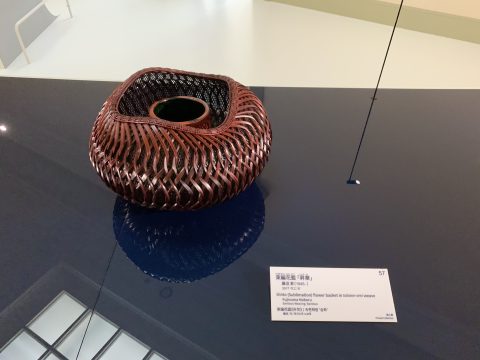
Noboru Fujinuma 《Bunched flower rattan “sublimation”》 2017 / Bamboo work / Private collection
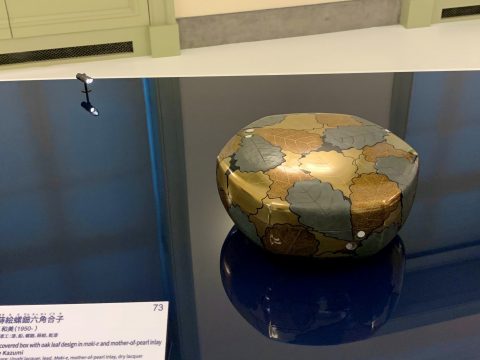
Kazumi Murose << Kashiwaba Makie Raden Hexagonal Goko >> 2014 / Lacquer / Private Collection
Among the 82 works exhibited this time, it is also worth seeing that there are more than 10 works of people who have been certified as Living National Treasures (holders of important intangible cultural properties).
"Maki-e" holder of important intangible cultural property, Kazumi Murose's "Kashiwaba Makie Raden Hexagonal Goko", "Bamboo craft" holder, Noboru Fujinuma's "Bunched flower rattan" sublimation "", "white porcelain" holder・This is a unique opportunity to enjoy gems that shine with traditional techniques such as Akihiro Maeta's "White porcelain porcelain jar" .
In addition, most of the 82 points are owned by individuals . I don't know when it will appear on the front stage next time, so it's a good idea to check in advance what kind of artist and what kind of work is exhibited.
You can check all the exhibited works and introductory texts on the official website of "Spinning Project" "Spinning Tsumugu: Japan Art & Culture" , so please take advantage of it.
② No display case! You can feel the work more closely
As you may have noticed in the photographs of the works introduced so far, there is no exhibition case to protect the works in this exhibition. (There are some exceptions)
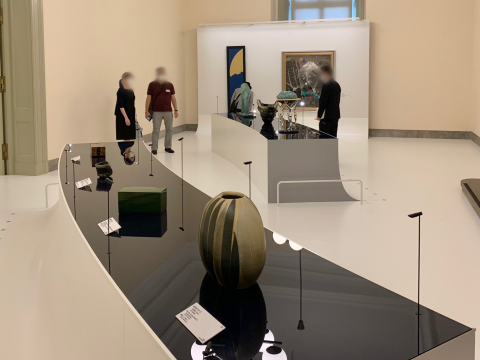
State of the exhibition
A dotted line is drawn at your feet, and the rule is to watch it without crossing that line. (Of course, it is NG to touch the work!)
There are many works, such as those with Kirikane decoration and Raden, whose impressions change dramatically depending on how the lights are applied and the viewing angle, so I am very grateful for this consideration.
③ You can concentrate on the work with a minimum of commentary
Also, the fact that there are very few explanations of the works in the venue of this exhibition may be different, but it is a good point for me personally. On the plate placed next to the work, only the artist name and work name, genre and material, and the holding place are written.
As you can imagine, the aim is to feel and think about the work without prejudice.
It may be unsatisfactory for those who want to understand the background of the work and then appreciate it firmly, but beginners may be able to devote themselves to the appreciation of the work. There are beginners including the author, but there is a danger that I will get tired on the way by reading the explanations one by one with all my strength because I try to understand the background.
"Spinning Tsumugu: Japan Art & Culture" introduces how to make and the background, but first of all, "How did you make this?" "I don't know what this is, but I want to decorate it in the bedroom." , It is recommended to come into contact with the work from a free perspective.

Craft genre commentary panel
A brief commentary panel is also on display at the venue for those who want to get an overview of each craft genre and how it is made.
④ Don't miss the space / building design
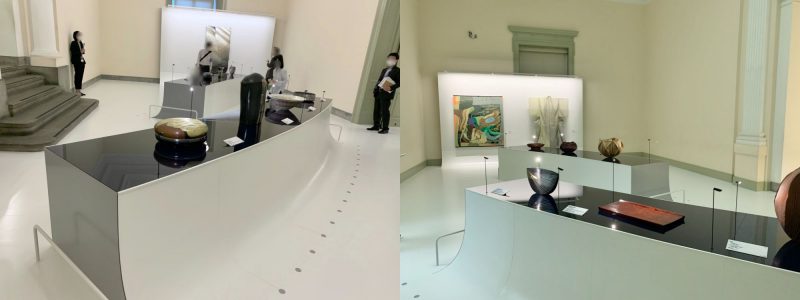
State of the exhibition
The space design for this exhibition was designed by world-famous architect Toyo Ito.
Reflecting the culture that crafts were placed directly on the floor (between the floors) in Japanese wooden architecture, we thought that the floor and the exhibition stand were continuous in this exhibition as well, and connected the floor and the vertical surface with a curve to display it. It is said that the table is defined as a raised floor.
If you look at the picture above, you can see that the floor and the exhibition stand are smoothly integrated.
"I tried to symbolically express that the natural energy swirling around the earth rises and becomes a work through the hands of the artist and is lined up on the exhibition stand." (From the panel "About the venue composition" in the venue Quote)
Ito explains.
As the words say, the exhibition stand connects the earth and the works, giving the impression that the exhibition hall itself has a sense of unity. The entire space, including the exhibition stand, had a presence as if it were the 83rd work.
The space concept is "the brilliance of natural life." By all means, not only the works, but also the exhibition stands, lighting, and benches were included one by one. We recommend that you enjoy watching the entire venue.

Dome roof of Hyokeikan
By the way, the Hyokeikan itself, the first full-scale museum in Japan that opened in 1909 (Meiji 42), is also a very beautiful and spectacular building.
Impressions that I actually watched
Originally, I should introduce the main works here, but as I mentioned, if you open "Spinning Tsumugu: Japan Art & Culture" , beautiful pictures of all the works will be introduced with explanations. It is easiest to see the detailed work introduction there …!
Therefore, in this article, I will pick up some works and introduce the impressions and points of interest such as "The real thing was like this" and "I like this place!". I hope you can feel the atmosphere of this exhibition as much as possible.
* This is an impression from a beginner's point of view, so please read it with a laid back feeling!
《Kirikane decoration “Shizuya Shi”》
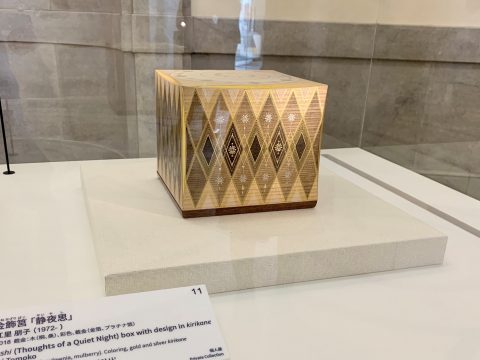
Tomoko Eri 《Kirikane Decorative Saza “Shizuya Shi”》 2018 / Kirikane / Private Collection
This is Tomoko Saza's "Kirikane decoration " Shizuya Shi "" that was displayed at the entrance. (Read "Kirikane Kazari Bako / Seiyashi")
The work was inspired by the poet "Quiet Night Thought" by Chinese poet Li Bai. "Shizuya Shi" is a poem that looks up at the moon and thinks of your hometown, but it seems that "Shizuya Shi" in this box was made with the image that the moon gently illuminates all things.
The box made of paulownia wood colored in black and white is decorated with gold and platinum foil, but the geometric pattern is just beautiful. I forgot that it was an interview and I instinctively looked at it. I really want you to see this delicate beauty.
A moist foil shine that is discreet yet assertive. There was an atmosphere of the gentle light of the moon.
《Kinrande coloring bowl》
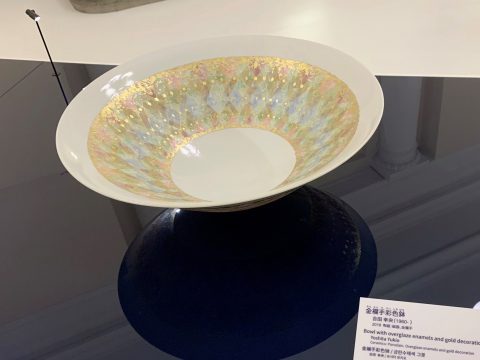
? Yukio 《Kinrande Colored Bowl》 2018 / Ceramic / Private Collection
Next is ? Yukio's "Kinrande Coloring Bowl" . It is a beautiful work of gold colored by the Kinrande technique.
"Shizuya Shi" had a chic atmosphere, but it is more gorgeous with pink and light blue. Especially wonderful was the gold color on the edge of the plate. The gold color drawn in the middle of the pattern is lined up in an orderly manner, but only the edges are shining irregularly as if they were dazzled.
The unevenness, combined with the colorfulness of the background, accentuates the luxurious impression. It seems that the leaves are thick and the flowers are scattered. You may be fascinated by the elegant beauty.
《The seat of the gods “Izumo”》
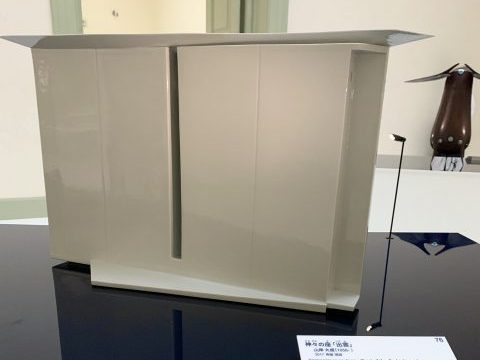
Taisei Yamagishi 《Izumo, the seat of the gods》 2017 / Ceramics / Private collection Taken from near the front

Taken from the back of "Izumo, the seat of the gods"
From the white and inorganic visuals, this work had an impression of "fashionable home appliances" at first glance. The fact that there are holes on the side and back that can be plugged in by USB further strengthened that image.
This is Mr. Taisei Yamagishi's "The seat of the gods" Izumo "". I'm sorry that I had a very rude impression about the work that tried the awe and prayer for the gods gathering in Izumo of Kannazuki and the great existence in the pure white.
After reading the explanation, when I watched it again, I felt as if I was refreshed by the clear, slimy white glow that gave off a clear atmosphere. The arrangement of the lights is exquisite, so please take a look at it from various angles while paying attention to how the light hits.
It's the seat of the gods, but is God sitting here? Maybe it goes in through the hole? It was a very interesting work that stirs up various imaginations. This is my favorite in this exhibition.
《A Silent Voyage》
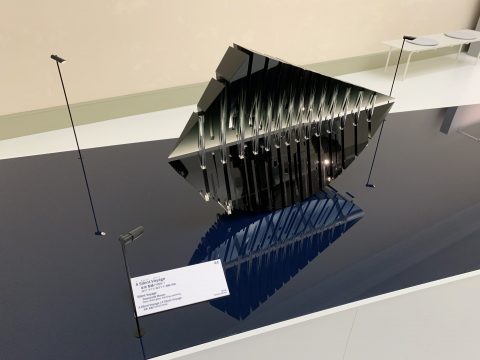
Seio Tomodate 《A Silent Voyage》 2017 / Glass / Private collection
Next, Mr. Seio Tomosada's "A Silent Voyage".
The work was created with the image that a ship sailing in a quiet sea in the moonlight can proceed calmly from the present situation to the future, which is at the mercy of various problems.
Black, which has a gradation toward the center, combined with the sophisticated presence of glass, created a sense of transparency that stands out among the works lined up. Depending on the angle, the gradation seems to hang in blue, purple, or green, just like the image of the sea.
Is this shape, which looks like a fish bone in the distance, a ship or a rippling sea? It was a work with a mysterious charm that made me want to touch it.
"Art is in a dream"
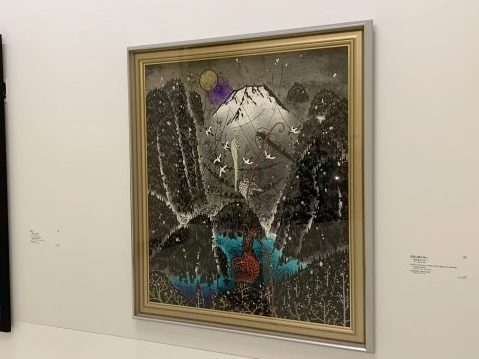
Toshio Hyakunuki << Art is in a dream >> 2014 / Dyeing / Weaving / Private collection
This is Toshio Hyakunuki's "Art is in a dream" .
Mr. Hyakunuki is a writer who freely expresses the world where various creatures and nature coexist in his own fantasy world with Kaga Yuzen. You seem to be inspired by the dream world you had.
This work is also dreamy and very strange. Huge spiny lobsters, owls, dragons and crane-like animals are drawn on lakes or rivers surrounded by mountains, but this kind of feeling was dreamy and familiar.
The impression that black, which is sometimes powerful and sometimes graceful, is immersing the dream world into this real world. It's easy to be fascinated by animals, but the vividness of the water makes it a must-see.
Besides that,
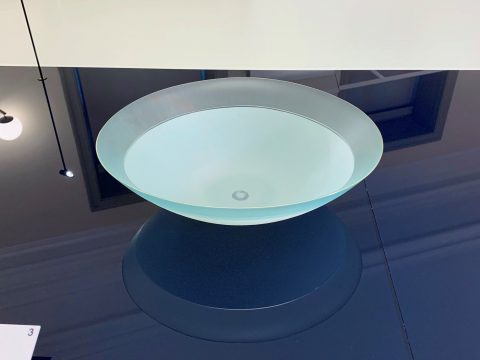
Masayoshi Adachi 《Glass silk thread crest bowl “Sunset”》 2019 / Glass / Private collection
When the winter day was tilted, Mr. Masayoshi Adachi's "Glass Silk Thread Crest Bowl" Sunset "" , which beautifully expresses the softness of the light seen through the shoji door in the Japanese-style room, feels warm.
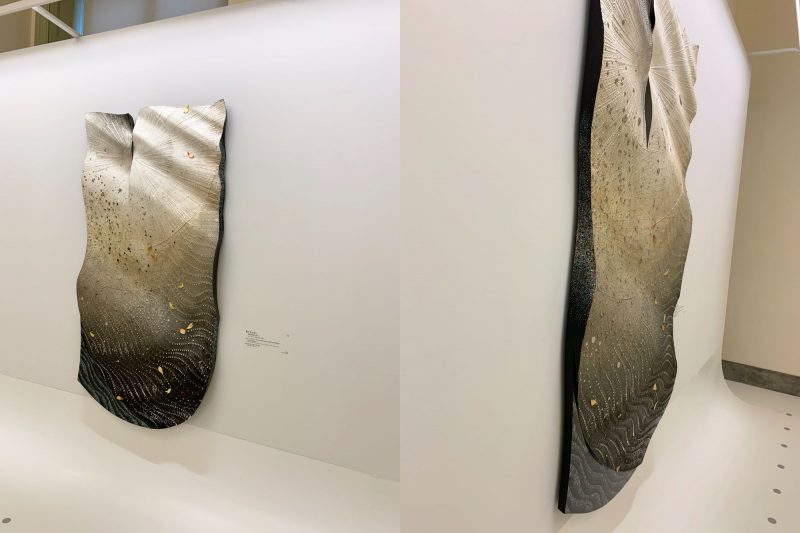
Yoshiken Murata 《Wind, Light and Water》 2019 / Laquer Ware / Private Collection (Left Photo) Taken from near the front (Right Photo) Taken from an angle
While drawing the brilliance of light and water in detail with Raden, foil stamping, and lacquer work, the masterpiece, Yoshiken Murata , whose height is nearly 2 meters and is sure to be overwhelming, such as "Wind, Light and Water" , etc.
I can't really introduce it, but there were a lot of works that even people who are not familiar with crafts can enjoy without problems!
At the end
We have reported on the preview of "Special Exhibition Crafts 2020-Nature and Beauty-" currently being held at the Tokyo National Museum Hyokeikan.
This exhibition is highly recommended not only for those who like crafts and are familiar with them, but also for those who are not familiar with them but want to see beautiful works of art and want to make it an entrance to the world of crafts.
Advance reservations are required for viewing, so don't forget to make a reservation!
Special Exhibition Craft 2020-Nature and Beauty- <Details>
Date: September 21st (Monday / holiday) -November 15th (Sunday), 2020
Venue: Tokyo National Museum Hyokeikan
Viewing method: Advance reservation system (date and time reserved ticket)
Opening hours: 9:30 am to 5:00 pm
* Open until 9 pm on Fridays and Saturdays
Closed: Monday
* Open on September 21st (Monday / holiday), closed on September 23rd (Wednesday)
